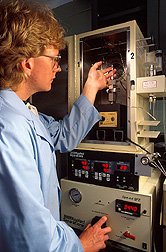Biocatalysis: Using Enzymes To Produce New Products
|
|
 Chemist Dave Compton adjusts the pressure-control gauge on a device while a biocatalysis reaction occurs inside. He is optimizing procedures for making an all-natural soy-based sunscreen. (K8679-1) |
The high productivity of U.S. agriculture in the 20th century was powered by the 19th century's Industrial Revolution and by the sciences of genetics and organic chemistry. Now, as late 20th century advances in molecular biology and information technology increase yields and use of renewable materials produced on farms, ARS scientists are focusing on making it all happen in ways that minimize risks to our environment.
Just as in the past 50 years, petroleum engineers have improved a process called catalysis—or fluidized catalytic cracking—to nearly maximize the amount of energy obtainable from a barrel of oil, agricultural scientists may develop biocatalysis to efficiently convert farm commodities into a variety of useful products. Biocatalysis is the process of using enzymes in a laboratory or factory to synthesize compounds. It's a "green"—environmentally friendly—process because it may not require petroleum-based solvents. And products made via biocatalysis can themselves be made from renewable resources. "This year we started researching biocatalysis as a way to synthesize novel fats and oils," said Joe Laszlo, a lead scientist in the Biomaterials Processing Research Unit at the National Center for Agricultural Utilization Research in Peoria, Illinois. So far, NCAUR chemist Dave Compton and Laszlo have used an enzyme to construct an ultraviolet light-absorbing sunscreen made from any of several vegetable oils and other natural plant components. Now Compton and Laszlo are teaming up with Jerry King, a chemist who leads the NCAUR's Food Quality and Safety Research Unit. The scientists are moving the research to a laboratory especially designed for processing larger amounts of vegetable oils at higher pressures and temperatures. In the larger setup, they are using supercritical carbon dioxide as a solvent for reacting and extracting compounds synthesized by the enzymes. In other research, King and his colleagues developed a two-step process using supercritical carbon dioxide, hydrogen, methanol, and an enzyme and another catalyst to convert soybean oil into hydrogen-saturated alcohol mixtures. Such mixtures are used to make soaps, detergents, and related chemicals. "With supercritical fluid extraction, we compress and heat a gas—usually carbon dioxide—so it becomes more dense and liquidlike," King explains. In this unique physical and chemical state, the carbon dioxide can pass through a mixture and dissolve specific fats or other materials. The gas is then decompressed and harmlessly vented into the atmosphere, leaving the extracted products behind.—By Ben Hardin, Agricultural Research Service Information Staff. This research is part of New Uses, Quality, and Marketability of Plant and Animal Products, an ARS National Program (#306) described on the World Wide Web at http://www.nps.ars.usda.gov/programs/cppvs.htm. David L. Compton, Joseph A. Laszlo, and Jerry W. King are at the USDA-ARS National Center for Agricultural Utilization Research, 1815 N. University St., Peoria, IL 61604; phone Compton (309) 681-6321, Laszlo (309) 681-6322, King (309) 681-6203, fax (309) 681-6685. |
|
"Biocatalysis: Using Enzymes To Produce New Products" was published in the February 2000 issue of Agricultural Research magazine.
|
|






